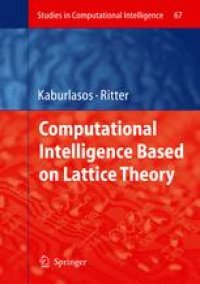
Ebook: Computational Intelligence Based on Lattice Theory
- Tags: Appl.Mathematics/Computational Methods of Engineering, Artificial Intelligence (incl. Robotics)
- Series: Studies in Computational Intelligence 67
- Year: 2007
- Publisher: Springer-Verlag Berlin Heidelberg
- Edition: 1
- Language: English
- pdf
The emergence of lattice theory within the field of computational intelligence (CI) is partially due to its proven effectiveness in neural computation. Moreover, lattice theory has the potential to unify a number of diverse concepts and aid in the cross-fertilization of both tools and ideas within the numerous subfields of CI. The compilation of this eighteen-chapter book is an initiative towards proliferating established knowledge in the hope to further expand it. This edited book is a balanced synthesis of four parts emphasizing, in turn, neural computation, mathematical morphology, machine learning, and (fuzzy) inference/logic. The articles here demonstrate how lattice theory may suggest viable alternatives in practical clustering, classification, pattern analysis, and regression applications.
The emergence of lattice theory within the field of computational intelligence (CI) is partially due to its proven effectiveness in neural computation. Moreover, lattice theory has the potential to unify a number of diverse concepts and aid in the cross-fertilization of both tools and ideas within the numerous subfields of CI. The compilation of this eighteen-chapter book is an initiative towards proliferating established knowledge in the hope to further expand it. This edited book is a balanced synthesis of four parts emphasizing, in turn, neural computation, mathematical morphology, machine learning, and (fuzzy) inference/logic. The articles here demonstrate how lattice theory may suggest viable alternatives in practical clustering, classification, pattern analysis, and regression applications.
The emergence of lattice theory within the field of computational intelligence (CI) is partially due to its proven effectiveness in neural computation. Moreover, lattice theory has the potential to unify a number of diverse concepts and aid in the cross-fertilization of both tools and ideas within the numerous subfields of CI. The compilation of this eighteen-chapter book is an initiative towards proliferating established knowledge in the hope to further expand it. This edited book is a balanced synthesis of four parts emphasizing, in turn, neural computation, mathematical morphology, machine learning, and (fuzzy) inference/logic. The articles here demonstrate how lattice theory may suggest viable alternatives in practical clustering, classification, pattern analysis, and regression applications.
Content:
Front Matter....Pages i-xvi
Front Matter....Pages 2-2
Granular Enhancement of Fuzzy ART/SOM Neural Classifiers Based on Lattice Theory....Pages 3-23
Learning in Lattice Neural Networks that Employ Dendritic Computing....Pages 25-44
Orthonormal Basis Lattice Neural Networks....Pages 45-58
Generalized Lattices Express Parallel Distributed Concept Learning....Pages 59-77
Front Matter....Pages 80-80
Noise Masking for Pattern Recall Using a Single Lattice Matrix Associative Memory....Pages 81-100
Convex Coordinates From Lattice Independent Sets for Visual Pattern Recognition....Pages 101-128
A Lattice-Based Approach to Mathematical Morphology for Greyscale and Colour Images....Pages 129-148
Morphological and Certain Fuzzy Morphological Associative Memories for Classification and Prediction....Pages 149-171
Front Matter....Pages 174-174
The Fuzzy Lattice Reasoning (FLR) Classifier for Mining Environmental Data....Pages 175-193
Machine Learning Techniques for Environmental Data Estimation....Pages 195-214
Application of Fuzzy Lattice Neurocomputing (FLN) in Ocean Satellite Images for Pattern Recognition....Pages 215-232
Genetically Engineered ART Architectures....Pages 233-262
Fuzzy Lattice Reasoning (FLR) Classification Using Similarity Measures....Pages 263-284
Front Matter....Pages 286-286
Fuzzy Prolog: Default Values to Represent Missing Information....Pages 287-308
Valuations on Lattices: Fuzzification and its Implications....Pages 309-324
L-fuzzy Sets and Intuitionistic Fuzzy Sets....Pages 325-339
A Family of Multi-valued t-norms and t-conorms....Pages 341-360
The Construction of Fuzzy-valued t-norms and t-conorms....Pages 361-370
Back Matter....Pages 371-375
The emergence of lattice theory within the field of computational intelligence (CI) is partially due to its proven effectiveness in neural computation. Moreover, lattice theory has the potential to unify a number of diverse concepts and aid in the cross-fertilization of both tools and ideas within the numerous subfields of CI. The compilation of this eighteen-chapter book is an initiative towards proliferating established knowledge in the hope to further expand it. This edited book is a balanced synthesis of four parts emphasizing, in turn, neural computation, mathematical morphology, machine learning, and (fuzzy) inference/logic. The articles here demonstrate how lattice theory may suggest viable alternatives in practical clustering, classification, pattern analysis, and regression applications.
Content:
Front Matter....Pages i-xvi
Front Matter....Pages 2-2
Granular Enhancement of Fuzzy ART/SOM Neural Classifiers Based on Lattice Theory....Pages 3-23
Learning in Lattice Neural Networks that Employ Dendritic Computing....Pages 25-44
Orthonormal Basis Lattice Neural Networks....Pages 45-58
Generalized Lattices Express Parallel Distributed Concept Learning....Pages 59-77
Front Matter....Pages 80-80
Noise Masking for Pattern Recall Using a Single Lattice Matrix Associative Memory....Pages 81-100
Convex Coordinates From Lattice Independent Sets for Visual Pattern Recognition....Pages 101-128
A Lattice-Based Approach to Mathematical Morphology for Greyscale and Colour Images....Pages 129-148
Morphological and Certain Fuzzy Morphological Associative Memories for Classification and Prediction....Pages 149-171
Front Matter....Pages 174-174
The Fuzzy Lattice Reasoning (FLR) Classifier for Mining Environmental Data....Pages 175-193
Machine Learning Techniques for Environmental Data Estimation....Pages 195-214
Application of Fuzzy Lattice Neurocomputing (FLN) in Ocean Satellite Images for Pattern Recognition....Pages 215-232
Genetically Engineered ART Architectures....Pages 233-262
Fuzzy Lattice Reasoning (FLR) Classification Using Similarity Measures....Pages 263-284
Front Matter....Pages 286-286
Fuzzy Prolog: Default Values to Represent Missing Information....Pages 287-308
Valuations on Lattices: Fuzzification and its Implications....Pages 309-324
L-fuzzy Sets and Intuitionistic Fuzzy Sets....Pages 325-339
A Family of Multi-valued t-norms and t-conorms....Pages 341-360
The Construction of Fuzzy-valued t-norms and t-conorms....Pages 361-370
Back Matter....Pages 371-375
....